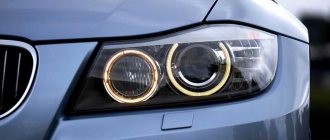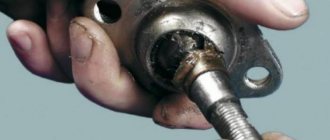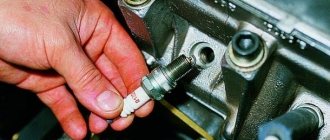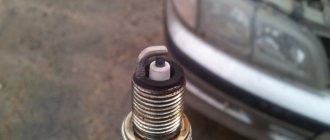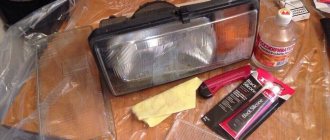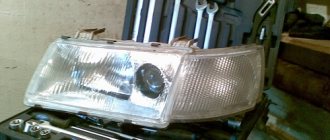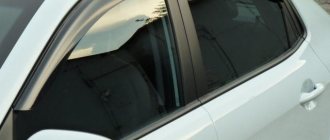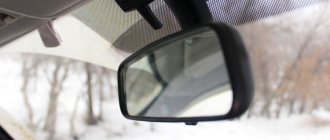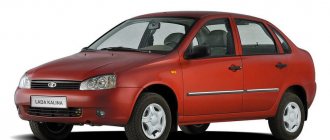Comments: no Published: 05/23/2016
Rating:
Tags: Cover a car headlight
Due to numerous situations on the roads, the appearance of the car may suffer. Due to mechanical damage, a crack may occur on the headlight glass. This breaks the seal of the optics and leads to a decrease in its service life (in particular, reflectors). In addition, water begins to flow inside the headlights and dust begins to fly in. In order to prevent undesirable consequences, cracks in car taillights and headlights must be promptly removed, and more specifically, glued together.
However, before you start gluing new sealant or tape when repairing headlights, a car enthusiast may be faced with the problem of getting rid of the old layer of sealing substance that was used to secure the car glass in the headlight or lantern.
Removing old sealant from a car headlight
How can you restore headlight reflectors with your own hands? The easiest way to get rid of the old layer of sealant is to remove it by heating it with a construction (or household, but its power is less) hairdryer. Direct a stream of hot air onto the surface - the composition will heat up and lose its properties. The heated sealant can be easily removed with a sharp screwdriver or knife. Do not heat plastic car parts to high temperatures - they can also melt, like sealant.
To glue car lights, you will need the following tools and materials:
- glue;
- sealant;
- acetone;
- adhesive fabric;
- soldering iron
Types of materials for gluing
To glue the headlight, glue is most often used. The following basic substances are used to glue car headlights:
- Terostat - 8600 2K;
- Terostat - 8599, 8597, 8596
- Terodicht - Black;
- Terodicht - Elastik;
- Permatex;
- Abro;
- Body.
Adhesive sealant for glasses and headlights PERMATEX 65 AR Silicone Glass Sealer
The second way to glue cracks in car headlights is with butyl tape. According to the manufacturers, it has enough advantages:
- ensures durability and reliability of fasteners;
- resistant to significant temperature changes;
- quickly sets to the surface;
- seals glass.
Butyl tape for gluing car optics
There are 2 types of sealed glue:
- one-component. Sold in a tube and initially ready for use, presented as a liquid mass;
- two-component. Presented in the form of a paste or dry mixture. As a rule, it is sold together with a solvent. Before gluing, it is diluted to the desired consistency before use.
One-component adhesive for car optics
Instructions for use for headlight adhesive
How to seal or replace a car washer reservoir
In order for the sealant to reliably connect the bonded surfaces, you must follow the manufacturer's recommendations. However, there are some general rules to maintain the transparency and color rendering ability of headlights.
Gluing must be done using the following algorithm:
- Before starting work, wipe the parts to be glued, clearing them of dirt and degreasing them (use white spirit, solvent, nefras, in extreme cases, acetone, which will not work if the car has plexiglass), avoiding contact with the paintwork of the body and plastic;
- if the room is cold (temperature lower than specified in the instructions), warm the surface with a hairdryer;
- remove old sealant;
- if the product is liquid, use a dispenser or a disposable medical syringe.
After installing glass or collecting broken pieces, remove excess product. If during the operation of the car you notice that peeling has occurred (this is a problem with polyurethane compounds), disassemble the block using a solvent on the same PU base.
What is needed for repairs
A standard set of tools and supplies for repairing cracks in car headlights usually consists of:
- technical napkins;
- sandpaper;
- microfiber;
- polishing liquid;
- masking tape;
- polishing sponge;
- sprayer;
- water;
- alcohol;
- urethane varnish;
- white spirit.
On average, recovery requires several hours of your time. If you have experience in restoration, you can use a grinding machine and abrasive wheels.
Stages of work
Conductive glue 4 homemade recipes. Conductive glue
To seal the glass you will need:
- prepare the glue itself. To do this, dilute it and, if necessary, heat it to the melting temperature indicated on the package;
- clean, dry and degrease the surface;
- To seal a crack, heat its edges, where the mixture will be applied next. This is done due to the fact that many types of glue can only be glued to hot (warm) surfaces;
- lubricate the surface and glue it without any effort;
- fix the crack on the tail light. For this purpose, fiberglass and wire are suitable, which must be secured with a frame on the damaged surface to prevent the development of cracks;
- allow the composition to dry (drying time is indicated on the packaging), then remove excess material.
Sealing glass on a car headlight
Alternative ways to glue a car headlight are as follows:
- If you want to glue imperfections on car glass the old fashioned way, you don’t have to buy glue, but get by using a soldering iron. It is suitable if your headlight is made of plastic, as it can melt its edges and glue them back together without the use of foreign substances.
- You can also glue a damaged tail light using plastic tablets. You just need to heat one tablet and then spread it on the damaged glass. After hardening, the surface is treated with a fine-grained abrasive (sandpaper, abrasive clay) to eliminate excess material.
- Sealant can seal cracks of different sizes well. The algorithm of actions here is similar to working with glue. You can choose a “native” sealant (the one used by the manufacturer of your car model) or buy a high-quality analogue. The main rule is to strictly follow the instructions, especially in terms of diluting and heating the composition.
- You can glue the cracks with a special cloth. It is laid at the crack site and filled with acetone. Acetone begins to dissolve the components of the fabric, transforming them into an adhesive composition. Car enthusiasts note the fast drying time of this mixture - approximately 1-1.5 hours.
Using plastic tablets we seal the rear light
If none of the above methods work for you, or you have not yet purchased sealant, you can temporarily seal the surface with tape. Pre-treat the surface as you would with glue and glue the crack. Scotch tape, depending on the quality of the work and the material itself, can glue a crack for a period of from several days to several months.
Headlight repair and restoration
The optics of the machine are subject to heavy mechanical loads, which can lead to damage to these elements. The reason may be the car owner’s inattention on the road or getting into an accident. Repairing a headlight is not difficult. All that is required is a tool, spare parts for replacement and sealant for fasteners.
Basic faults
Restoration of the headlight is required in a situation where deformation or damage leads to a deterioration in the light transmission of the product. As a result, the risk of getting into an accident when driving at night increases. In addition, yellowed plastic does not have the most presentable appearance.
Common headlight defects that car owners encounter include:
- The appearance of cracks in the glass.
- Violation of tightness at the joints.
- Damage to the case and fastening elements, scratches and chips.
It is worth noting that headlight repair may be required in the following cases:
The appearance of plaque inside
The problem may occur if chemicals get inside the product. Under the influence of high temperatures, a coating forms on the outer part of the glass, which reduces the throughput of the headlight. In addition, due to the appearance of a foreign “film”, the glass may acquire a yellow tint. In this case, it is better to involve professionals to restore the headlight.
Scuffs or chips on the surface of the headlight may cause it to fog up. If the defect is not corrected in a timely manner, the mirror layer is damaged and the lamp requires repair. Moisture also has a negative impact, the ingress of which leads to oxidation of contact connections. That is why, when fogging occurs, it is important to quickly solve the problem and repair the headlight. To restore the tightness, you can use a sealant.
Why the headlight sweats, and what to do in this case - read here .
Cracks in the protective layer
In this case, it will be destroyed by the action of “chemistry” and UV rays.
This problem is known to many, if not all car owners. To restore the headlight, grinding and polishing of the surface is used. With the right approach, you can return the glass to its original appearance. It is advisable to repair the lantern only if you have experience, confidence in your abilities and knowledge of the technology for performing the work.
Polishing headlights on a car
How to repair a headlight with your own hands: step-by-step instructions
Along with the restoration, you can also do other work - tuning the car's headlights, for example, applying paint to them. One popular option is to apply black paint.
To repair the headlight, do the following:
- Prepare the problem area - clean it, wash and dry.
- Fill the hole with adhesive. Make sure that no bubbles appear during the procedure.
- Use a UV lamp to dry the repair area.
- Secure the result. To do this, cover the existing crack with a hardener.
- Polish the restoration area using a grinder or sandpaper.
In addition to restoring the headlight, restoration of the reflector may be required. To do this, do the following:
- Peel off the reflector using metal tape.
- Apply chrome paint to the reflector.
As an alternative, when repairing the reflector, metal foil or film can be used, followed by fastening with sealant.
Video: How to properly restore headlights
If the video doesn't show, refresh the page or click here
How to restore the corrector
The task of the headlight hydrocorrector is to change the direction of the light beam. If the device fails, then adjusting the beam becomes an unrealistic task. That is why repair of the corrector should be carried out immediately after a breakdown is detected. If restoration is not possible, replace the part completely.
To do this, do the following:
- Remove the corrector handle.
- Unscrew the fastening nut and remove the master cylinder.
- Use a screwdriver to unscrew the fastener, remove the casing, scale and light guide.
- Remove the scale illumination bulb to easily dismantle the hydraulic corrector.
- Remove the vehicle headlights from the working cylinders.
- Remove the corrector in the assembly.
- After installing the new device, return all elements using the reverse algorithm.
Video: Repair of hydraulic corrector for Lada Granta headlights
If the video doesn't show, refresh the page or click here
How to repair a plastic headlight
Car owners are often interested in how to repair plastic headlights.
The best way to glue headlight glass types of sealants
How to Remove Label Adhesive from Glass
The market offers a fairly extensive range of compositions that differ in chemical properties, ease of use, and cost. What to choose? First you need to understand the classification. There are 4 types of sealants for headlights and car glass.
For better bonding, it is better to dismantle the headlight
Silicone
In terms of composition before polymerization, these are semi-liquid fluid products made from natural or artificial rubber. After application, the material hardens, turning into a kind of rubber that glues surfaces, protects from UV radiation and seals joints. But silicone products have a significant disadvantage - poor resistance to chemically aggressive environments, for example, technical oil, gasoline, diesel fuel, etc.
This is especially important if the car has a headlight washer system, which uses a special liquid that contributes to the process of destruction of the sealant, but sometimes oil-resistant products are found. In winter, it is also affected by anti-ice reagents
The main advantage of silicone compounds is their low cost and the ability not to lose their properties over a wide temperature range - up to +100°C. Ideal for mounting fog lamp lenses.
Polyurethane
These automotive sealants are very helpful in situations where you need to glue individual fragments of broken headlight glass or simply repair a chip or crack. The main advantage of polyurethane compounds is high adhesion (stickability) and good adhesive properties. Dried polyurethane based sealant is water resistant.
There are other advantages:
- The adhesive material can be used in a wide temperature range - from minus 60 to plus 80°C;
- service life reaches several years;
- the composition is resistant to the effects of motor oil, fuel, alcohol washer fluid and anti-ice agents;
- good fluidity before polymerization makes it possible to connect fragments of the most complex configuration;
- frost resistance;
- The glued structure reliably resists vibration.
Polyurethane sealant: everything is written on the package
What about the disadvantages? They are also available. The first is toxicity, which requires compliance with special safety rules: you need to work in rubber gloves, goggles, and sometimes a respirator (if the amount of work is large, for example, in a machine shop). And another disadvantage is poor resistance to high (more than +120°C) temperatures, which is typical for halogen lamps. However, the product is quite suitable for repairing mirrors.
Anaerobic
These compositions are characterized by high strength and resistance to high temperatures (up to +200°C). Sealants of this type are used for sealing joints and seams. Before polymerization, anaerobic sealants are in liquid form. Because of this, there are some inconveniences during use. But the chemical composition of the product is harmless to humans, and additional protection in the form of gloves and glasses is not required. The only requirement is to prevent the sealant from getting into your mouth and eyes.
Heat resistant (high temperature)
The main advantage of these sealants for headlights and car glass follows from their name. Compositions of this type can easily withstand temperatures up to +300 and even +400°C. That is, these heat sealants are well suited for working with headlight lenses that contain halogen lamps. The heat-resistant product is quite durable and is not afraid of vibration and mechanical impact. Heat-resistant sealants are produced in paste form or in two-component form. There is also a drawback to high-temperature auto sealant - a long hardening time, reaching up to 8-12 hours.
Rating of the best sealants
To work with automotive optics, you need to purchase high-quality products so as not to experience problems with the functioning of lighting devices.
ABRO WS 904
ABRO WS 904 sealant is one of the most popular according to user requests. It is sold in the form of adhesive tape in rolls of different sizes, made on the basis of vulcanized polyisobutylene, a derivative of artificial rubber.
This butyl headlight sealant is highly elastic and easy to use - you just need to cut a piece of tape of the required size, stretch it and stick it to the surface. It only takes a few seconds to connect the ends of the tape to each other - the polymerization process occurs quickly. At low ambient temperatures, it is recommended to additionally heat the sealant with a hair dryer.
The advantages of ABRO WS 904 tape are as follows:
- low consumption - the packaging is enough to completely seal a set of headlights,
- ease of installation - the tape does not stick to your hands, is flexible, easy to cut, stretches to achieve the desired thickness without effort,
- high degree of adhesion to most materials,
- no toxic emissions or unpleasant odor,
- strength, long service life after hardening, reliability and complete tightness of the seams.
Dow Corning 7091
It is recommended to purchase this sealant when working with dissimilar materials that have unequal coefficients of thermal expansion. It is capable of creating high-quality joints at the junctions of glass and metal, glass and plastic, and metal and plastic, so it is perfect for installing and repairing automotive optics.
Dow Corning 7091 Silicone Sealant is a one-pack, ready-to-use product that is both durable and flexible. The sealant is suitable not only for working with car headlights, but also for installing LED lamps, various electronic devices and complex mechanisms. After polymerization, the formed seam will reliably seal the joint, while it is not destroyed by temperature changes and can be used at -55...+185 degrees. The sealant is easy to further process, if required, and is a good dielectric.
DoneDeal DD6870
The composition of DoneDeal DD6870 refers to polyurethane sealants, includes urethane groups, petroleum products, various polymers, adhesion enhancers and other additives.
It can be used for installation and sealing purposes:
- headlights,
- glass,
- lanterns,
- lamps,
- hatches,
- instead of gaskets.
The sealant dries completely within 15–30 minutes after application, has high strength seams, good adhesion to most materials, and does not crack under the influence of vibration or shock. The product is characterized by moisture resistance and works without loss of properties in the temperature range from -60 to +270 degrees.
3M PU 590
3M PU 590 sealant is produced in the USA, has a polyurethane base, and is packaged in convenient tubes of 300–600 g. It does not tolerate high temperatures (withstands up to +100 degrees), so it is not used on hot car components. The product polymerizes quickly (in 25–30 minutes), does not react to acids, alkalis, solvents, is resistant to moisture and UV radiation, and reliably connects even dissimilar materials. Once cured, the sealed joint can be painted over with most automotive paints.
Emfimastic PB
This brand of adhesive-sealant is produced in France and contains polyurethane groups and various improving additives. Ethermastic glues homogeneous and dissimilar materials as reliably as possible, ideal for installation and repair of automotive optics. The composition is odorless, hardens in half an hour, does not shrink, and does not crack over time. It is not harmful to humans, has no unpleasant odor, and can be used even indoors. To apply this flexible sealant you will need a hand or air gun.
We understand the types of sealant to glue headlights on
Headlight glass adhesive helps repair damaged headlight glass. The use of this composition is due to the fact that the optical device is not allowed to pass through liquids and air. If this happens, condensation will form on the glass. This, in turn, will greatly deteriorate the quality of lighting and weaken the diffuser. In addition, such a defect will significantly spoil the appearance of the vehicle.
Today on the automotive market there is a wide range of similar products for every taste. These include liquid sealants for windshields, for replacing gaskets in the engine and other car parts. If the composition is produced in liquid format, it is equipped with special removable dispensers. Those who decide to buy headlight sealant in paste format should be prepared to dilute it with a special substance that comes with the product.
It is customary to glue optical instruments with one-component sealants, which are immediately ready for use. for headlights is available in different packaging options: you can find it both in bottles and tubes, and in the form of rolled tapes. Let's take a closer look at which sealant is best for headlights.
Professional headlight sealant by category
Silicone sealants. With their help, you can create an elastic adhesive pad that can replace the old one. Once it hardens, the product gains flexibility comparable to that of rubber. The main advantage of this sealant is simplicity and ease of use, resistance to various temperature conditions. The disadvantages include poor tolerance to gasoline, antifreeze and oil, so silicone cannot be used when repairing a gearbox or radiator.
Sealants for headlight glasses made of polyurethane. Such compositions are characterized by an increased level of adhesiveness and increased moisture resistance. The materials are perfect for gluing headlight lenses. Motorists and auto mechanics note the reliability of the connection and long service life
It is important that such sealants are not recommended for fixing moving auto parts.
Anaerobic compositions differ in their properties in that they do not solidify upon contact with air. Therefore, you can not be afraid to apply them to spare parts, because hardening occurs exactly when the parts to be glued begin to come into contact with each other
Such sealants can withstand both low and very high temperatures without changing their original qualities. How long an anaerobic sealant takes to dry is indicated in the composition instructions.
Heat-resistant sealants. Thermal sealant for headlights is characterized by increased resistance to load and vibration. Can withstand temperatures up to 375 degrees Celsius. Available in aerosol, powder or paste format. If the buyer chooses powder, it will have to be diluted first. The main disadvantage of this type of sealant is the long drying period, which takes at least ten hours.
What else to look for when choosing a product
When buying headlight sealant, in addition to its composition, as described above, it is necessary to take into account other criteria:
- Vibration resistance. When driving, the headlights shake and the sealant should not burst on the first bump.
- “Tolerance” to high temperatures: if you have halogen optics, choose an appropriate sealant.
- The volume of one package should be enough to repair at least one headlight.
- Removing excess. Particles of the product should be easily removed from any surface - metal or glass.
- Transparency. This point is important when repairing cracks in glass. If the product interferes with the emission of light, the efficiency of the headlight will be low, so a colorless composition is needed.
- Brand. Expensive does not mean good. However, cheap products will not provide reliable sealing, and the procedure will have to be repeated again and again, which is fraught with unnecessary financial expenses.
How to remove sealant from a headlight or glass
One of the most effective methods is to heat the sealant. After softening it can be removed freely
When doing this, be careful not to melt the plastic elements of the headlight unit. Residues can be removed with any automotive solvent and a flat screwdriver: the main thing is not to scratch the surface and wait 10-15 minutes. Then you can carefully scrape off the excess with a knife.
The choice of one or another sealing composition depends on the type of lamp in the headlight. In normal cases, polyurethane or silicone products are suitable, but if the optics are halogen-filled, use heat-resistant sealants, which can be found at any auto store.
Removing old sealant
Most often, when installing a new headlight, particles of the previous sealing compound are present on the base. Removing it can be a problem, especially if the product is polyurethane based. You must work carefully so as not to scratch the base or damage important elements. There are several ways to remove sealant:
When installing headlights, it is better to use proven, reliable sealants and strictly follow the instructions for their use - in this case, the optics will last a long time and will not cause problems on the road.
Source
How to properly replace glass on a headlight
There are only two methods, one of which involves quick dismantling of the auto glass and replacement, the second will require complete disassembly of the headlight unit. The use of one or another method depends on the tasks facing the motorist and the degree of glass damage (example on a VAZ 2107):
- Remove the radiator grille.
- Unscrew the bumper mounting bolts and remove it.
- Find the 3 bolts holding the headlight unit and remove them.
- Recess the headlight into the engine compartment.
- Take the eyelash and pull the block towards the center of the car.
- Using a screwdriver, pry up the eyelashes, then remove the headlight, freeing it from the bumper.
- Unscrew the lower fastening nut.
- Disconnect the connectors.
- Pull out the headlight.
Removed headlight 2107
Then you can remove the glass, check the rubber gasket and clean it. If it is torn, buy a new one. Assembly is carried out in reverse order. Assembly will be faster if you hook the headlight brackets to its housing, then lightly press and snap into place. Reinstall the glass in the opposite order.

